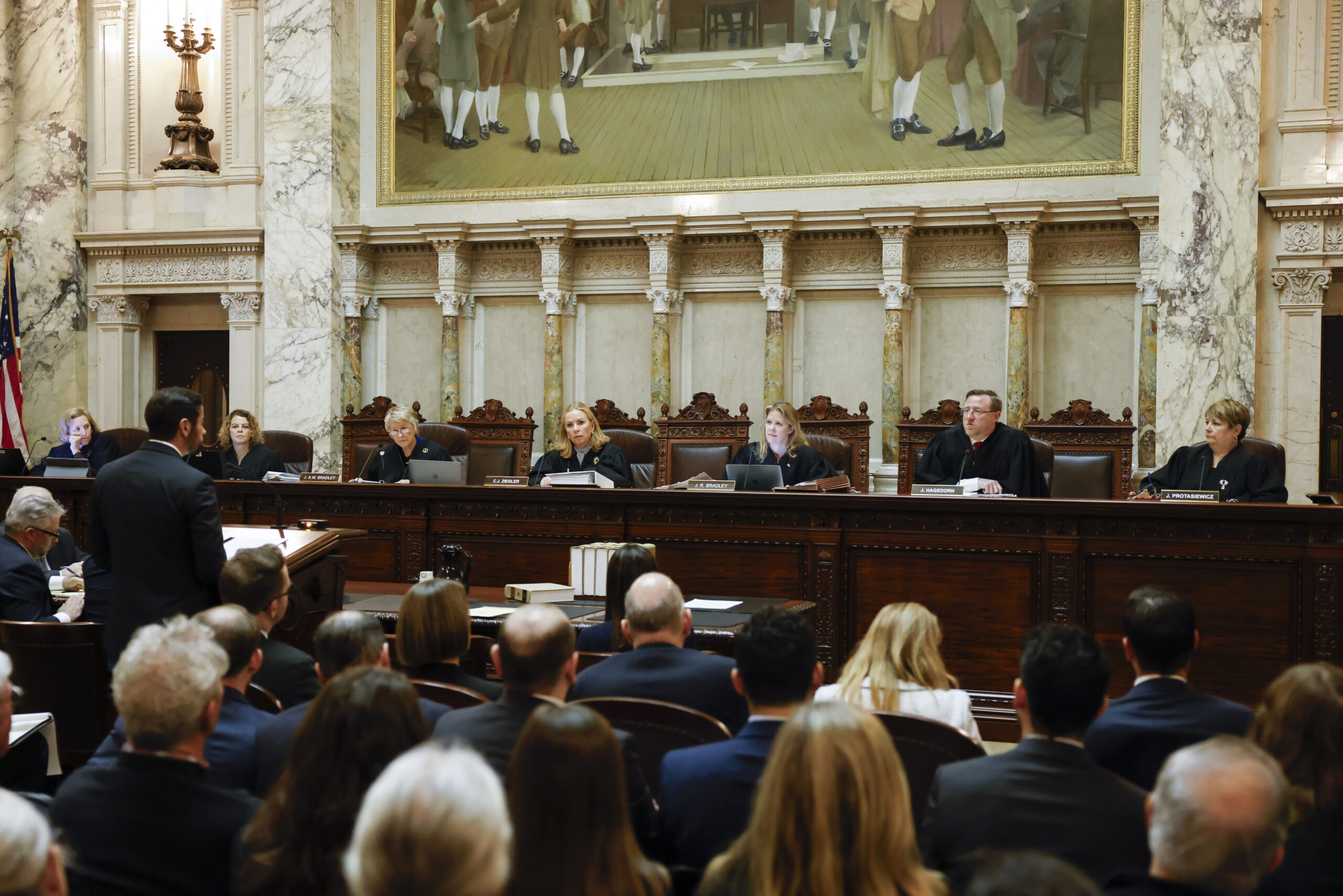Two lawsuits have been filed asking the Wisconsin Supreme Court to declare the state’s congressional map unconstitutional ahead of the 2026 midterm elections.
The lawsuits come roughly a month after liberals retained their majority on the court with the election of Dane County Judge Susan Crawford. They also come about a year-and-a-half after liberal justices struck down Wisconsin’s political maps for the state Senate and Assembly.
The new suits ask the state’s highest court to strike down Wisconsin’s congressional map, which has helped Republicans hold six of eight congressional seats, but they take different angles to get there.
Both focus on a “least changes” directive from the Supreme Court’s former conservative majority in 2021 that preserved a Republican advantage in maps for Congress and the Legislature.
Stay informed on the latest news
Sign up for WPR’s email newsletter.
Elias Law Group challenge focuses on partisan gerrymandering claims
One of the petitions was filed by the Democratic firm Elias Law Group. It claims the state’s congressional map, endorsed by the court’s former conservative majority in 2021, violates several sections of the Wisconsin Constitution.
The case claims the map violates Democratic voters’ rights to free speech and association under the state constitution because despite nearly equal numbers of Democratic and Republican votes in Wisconsin’s statewide elections, the GOP has been able to hold six of eight congressional districts.
“This congressional map directly discriminates against Petitioners, who support Democratic candidates in Wisconsin and—because of that affiliation—are effectively silenced and shut out from casting a meaningful congressional vote,” the lawsuit states. “Wisconsin’s Constitution prohibits this injustice several times over. This Court should grant this original action and replace the adopted congressional map with a lawful alternative.”
The Elias Law Group’s suit also claims the congressional map should be tossed because it was drawn by Democratic Gov. Tony Evers under the “least changes” directive from 2021. In its 2023 ruling that struck down state legislative maps, the court’s liberal majority did not allow parties to use the “least change” criteria, saying it had no basis in the constitution.
Campaign Legal Center lawsuit focuses on ‘malapportionment’ and county splits
The other lawsuit challenging the congressional map was filed by the Campaign Legal Center, one of the groups behind the successful lawsuit against the state legislative maps.
The Campaign Legal Center’s challenge claims the congressional map violates the state constitution’s guarantee of equality because it “does not equally apportion population among Wisconsin’s eight congressional districts.”
The suit also focused on the number of counties that were split when the current congressional map was approved by the court three years ago. It claims the former conservative majority erroneously put more importance on the “least changes” directive than “traditional redistricting” principles in the Wisconsin Constitution, like minimizing the number of counties that are split to form congressional districts. It alleges an “eight district map need only have seven county splits to achieve population equality” while the current map has 12.
“Thus, in addition to being unequally populated, the current congressional map is an improper court-imposed remedy because it elevated ‘least change’ over Wisconsin’s traditional redistricting criteria of minimizing county splits, resulting in the needless splitting apart of counties (and therefore communities of interest),” the lawsuit states.
Could Wisconsin Supreme Court ruling on congressional map wind up before US Supreme Court?
Lucas Vebber is an attorney with the conservative Wisconsin Institute for Law and Liberty, or WILL, which helped develop the “least changes” approach that was used by the state Supreme Court in 2021. He told WPR the approach makes sense because the primary role of redistricting falls on state legislatures.
Vebber said the Elias Law Group’s gerrymandering claims are “something that our court has never taken up before and ruled on,” and if they do, there’s a chance the U.S. Supreme Court could get involved.
Vebber said even though the state Supreme Court’s liberal majority declared Republican-drawn Assembly and Senate maps unconstitutional in 2023, they avoided the broader partisan gerrymandering claims being brought in the Elias Law Group’s case. Instead, that 2023 ruling focused on a more narrow claim that the maps violated the state constitution’s requirement that districts be contiguous.
Moreover, Vebber said if the Wisconsin Supreme Court does order a new congressional district map, it could trigger U.S. constitutional issues that would be subject to review by federal courts. He said a 2023 U.S. Supreme Court decision known as Moore v. Harper cautioned that state courts do not have “free rein” to strike down maps and election laws passed by state legislatures.
“Coming back for a second bite at the apple here on congressional maps in the middle of the decade, after several elections have already happened, may well trigger what the U.S. Supreme Court warned against,” Vebber said.
University of Wisconsin Law School Professor Robert Yablon, who co-directs the State Democracy Research Initiative, said he’s not sure it’s that simple. He said the Moore v. Harper ruling found that the U.S. Constitution doesn’t “insulate state legislatures from the ordinary exercise of state judicial review” when drawing new voting maps.
“But it did seem like they were signaling that state courts should be a little bit careful about how they handle these cases, and they shouldn’t do things that are completely novel,” Yablon said. “They shouldn’t develop standards that are maybe out of step with how they’ve litigated cases before.”
Yablon said one other caveat is that Wisconsin’s congressional map wasn’t passed by the Legislature, but it was instead put into place by the state Supreme Court.
UCLA law professor Rick Hasen said the “least changes” directive from the Wisconsin court’s former majority “essentially grandfathers in the old partisan gerrymanders” of the GOP maps from 2011. He said it’s not shocking to see Democrats trying to pick at the former conservative majority’s ruling now that liberals are in control.
“So now the state court is going to decide how to judge the constitutionality under the state constitution of a redistricting plan,” Hasen said.
Hasen said regardless of which branch enacted Wisconsin’s current congressional map, a federal challenge of any decision from the state Supreme Court wouldn’t be surprising.
Wisconsin Public Radio, © Copyright 2025, Board of Regents of the University of Wisconsin System and Wisconsin Educational Communications Board.





